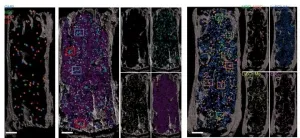Sinai team builds first model acute myeloid leukemia progression using CRISPR
Could help identify early-stage therapeutic targets
2021-02-10
(Press-News.org) (New York, NY) February 10, 2021 - A research team led by the Icahn School of Medicine at Mount Sinai (Icahn Mount Sinai) has built the first cellular model to depict the evolution of acute myeloid leukemia (AML), from its early to late stages. By using gene editing technologies to alter genes that make cells malignant, the team was able to identify potential therapeutic targets for early disease stages. The study was reported in the journal Cell Stem Cell in February.
The therapeutic targets could be applicable not just to AML but also to the blood cancer myelodysplastic syndrome and clonal hematopoiesis, which is often a preleukemic condition.
"We essentially built from scratch a model of leukemia that characterizes the molecular changes that underlie progression of the disease, and which allowed us to identify the earliest events in its development that can be therapeutically targeted," said Eirini Papapetrou, MD, PhD, Associate Professor of Oncological Sciences at Icahn Mount Sinai, and senior author of the study. "By creating the first cellular model to track the evolution of human leukemia, we believe we've taken an important step toward unraveling the cellular biology of this disease. We've identified molecular vulnerabilities that occur early in the disease process which could potentially lead to improved biomarkers and novel treatments for AML--goals that have proven so elusive to medical science in the past."
AML is a cancer of the blood and bone marrow, the spongy tissue inside bones where blood cells are made. The disease, which primarily affects white blood cells, is one of the most common leukemias in adults, with more than 20,000 newly diagnosed cases each year in the United States. While several new drugs have been introduced in recent years targeting the disease, they have fallen short of significantly changing patient outcomes or survival.
By introducing specific leukemia-causing gene mutations through CRISPR-mediated gene editing, Icahn Mount Sinai researchers were determined to better understand the successive stages of the evolution of leukemia. CRISPR is a powerful tool that allowed the team to alter the DNA sequences in induced pluripotent stem cells (iPSCs) to create a model with an increasing number of mutated genes that shows progressive malignant features that correspond to their human counterparts in myeloid disease. CRISPR gene editing uses Cas9, an enzyme that acts like a pair of molecular scissors with the ability to cut strands of DNA. Through use of these tools, the researchers were able to recapitulate the step-by-step conversion of a normal cell into a malignant one.
"CRISPR/Cas9 and iPSC technologies gave us the unique opportunity to characterize changes underlying the transitions between stages of AML, and to harness patterns of these changes to pinpoint target genes for early intervention," explains Dr. Papapetrou.
Specifically, the researchers found that inflammatory and innate immunity pathways constitute such early targets and demonstrated that inhibitors of these pathways, therapies that are being trialed in blood cancers and immune-related disorders, may be promising therapeutic modalities for AML and myelodysplastic syndrome.
INFORMATION:
Other partners in the study included Memorial Sloan Kettering Cancer Center in New York, and Cincinnati Children's Hospital Medical Center.
About the Mount Sinai Health System
The Mount Sinai Health System is New York City's largest academic medical system, encompassing eight hospitals, a leading medical school, and a vast network of ambulatory practices throughout the greater New York region. Mount Sinai is a national and international source of unrivaled education, translational research and discovery, and collaborative clinical leadership ensuring that we deliver the highest quality care--from prevention to treatment of the most serious and complex human diseases. The Health System includes more than 7,200 physicians and features a robust and continually expanding network of multispecialty services, including more than 400 ambulatory practice locations throughout the five boroughs of New York City, Westchester, and Long Island. The Mount Sinai Hospital is ranked No. 14 on U.S. News & World Report's "Honor Roll" of the Top 20 Best Hospitals in the country and the Icahn School of Medicine as one of the Top 20 Best Medical Schools in country. Mount Sinai Health System hospitals are consistently ranked regionally by specialty and our physicians in the top 1% of all physicians nationally by U.S. News & World Report.
For more information, visit https://www.mountsinai.org or find Mount Sinai on Facebook, Twitter and YouTube.
ELSE PRESS RELEASES FROM THIS DATE:
2021-02-10
Global emissions of a potent substance notorious for depleting the Earth's ozone layer - the protective barrier which absorbs the Sun's harmful UV rays - have fallen rapidly and are now back on the decline, according to new research.
Two international studies published today in Nature, show emissions of CFC-11, one of the many chlorofluorocarbon (CFC) chemicals once widely used in refrigerators and insulating foams, are back on the decline less than two years after the exposure of their shock resurgence in the wake of suspected rogue production.
Dr Luke Western, from the University of Bristol, a co-lead author of one ...
2021-02-10
When we tear a muscle " stem cells within it repair the problem. We can see this occurring not only in severe muscle wasting diseases such as muscular dystrophy and in war veterans who survive catastrophic limb injuries, but also in our day to day lives when we pull a muscle.
Also when we age and become frail we lose much of our muscle and our stem cells don't seem to be able to work as well as we age.
These muscle stem cells are invisible engines that drive the tissue's growth and repair after such injuries. But growing these cells in the lab and then using them to therapeutically replace damaged muscle has been frustratingly difficult.
Researchers at the Australian Regenerative Medicine Institute at Monash University in Melbourne, ...
2021-02-10
Researchers at the Centre for Genomic Regulation (CRG) reveal that newly formed embryos clear dying cells to maximise their chances of survival. It is the earliest display of an innate immune response found in vertebrate animals to date.
The findings, which are published today in the journal Nature, may aid future efforts to understand why some embryos fail to form in the earliest stages of development, and lead to new clinical efforts in treating infertility or early miscarriages.
An embryo is fragile in the first hours after its formation. Rapid cell division and environmental stress make them prone to cellular errors, which in turn cause the sporadic death of embryonic stem cells. This is ...
2021-02-10
For nearly a century, scientists have worked to unravel the mystery of dark matter--an elusive substance that spreads through the universe and likely makes up much of its mass, but has so far proven impossible to detect in experiments. Now, a team of researchers have used an innovative technique called "quantum squeezing" to dramatically speed up the search for one candidate for dark matter in the lab.
The findings, published today in the journal Nature, center on an incredibly lightweight and as-of-yet undiscovered particle called the axion. According to theory, axions are likely billions to trillions of times smaller than electrons and may have been created during the Big Bang in humungous numbers--enough ...
2021-02-10
What The Study Did: This observational study describes differences in the number of COVID-19 deaths by nursing home racial composition and examines the factors associated with these differences.
Authors: Rebecca J. Gorges, Ph.D., of the University of Chicago, is the corresponding author.
To access the embargoed study: Visit our For The Media website at this link https://media.jamanetwork.com/
(doi:10.1001/jamanetworkopen.2020.37431)
Editor's Note: The article includes funding/support disclosures. Please see the article for additional information, including other authors, author contributions and affiliations, conflict of interest ...
2021-02-10
What The Study Did: This article revisits the role of dermatologists in the early HIV/AIDS epidemic for the 40th anniversary of the epidemic.
Authors: Heather Milbar, M.D., M.P.H., of the University of Pennsylvania in Philadelphia, is the corresponding author.
To access the embargoed study: Visit our For The Media website at this link https://media.jamanetwork.com/
(doi:10.1001/jamadermatol.2020.5545)
Editor's Note: Please see the article for additional information, including other authors, author contributions and affiliations, conflict of interest and financial disclosures, and funding and support.
INFORMATION:
Media ...
2021-02-10
What The Study Did: Researchers examined changes in how organ donation from deceased donors differed by race and ethnicity in the United States over time.
Authors: Dorry L. Segev, M.D., Ph.D., of the Johns Hopkins University School of Medicine in Baltimore, is the corresponding author.
To access the embargoed study: Visit our For The Media website at this link https://media.jamanetwork.com/
(doi:10.1001/jamasurg.2020.7083)
Editor's Note: The article includes conflicts of interest and funding/support disclosures. Please see the article for additional information, including other authors, author contributions and affiliations, conflict of interest and financial disclosures, and funding and support.
INFORMATION:
Media advisory: The full study is linked to this news ...
2021-02-10
Researchers in Southampton and San Francisco have developed the first compact 3D LiDAR imaging system that can match and exceed the performance and accuracy of most advanced, mechanical systems currently used.
3D LiDAR can provide accurate imaging and mapping for many applications; it is the "eyes" for autonomous cars and is used in facial recognition software and by autonomous robots and drones. Accurate imaging is essential for machines to map and interact with the physical world but the size and costs of the technology currently needed has limited LIDAR's use in ...
2021-02-10
CINCINNATI--Imagine a day when clinicians treating people with blood diseases such as leukemia or multiple myeloma can send in requests for laboratories to custom-produce specific types of blood cells to replace those affected by the disease.
That day became one step closer to reality with a new study led by experts at Cincinnati Children's that provides powerful new insights into how bone marrow tissue works.
The study, published Feb. 10, 2021 in Nature, was led by senior author Daniel Lucas, PhD, and first authors Jizhou Zhang, MD, and Qingqing Wu, PhD, from the Division of Experimental Hematology and Cancer Biology. Co-authors include a team of scientists from Cincinnati Children's and the University of Cincinnati, plus collaborators in Colorado, Texas and Michigan.
The ...
2021-02-10
Imaging planets orbiting around nearby stars, which could potentially harbour life, has become a possibility thanks to the progress made in observational methods by an international team of astronomers. First candidate: Alpha Centauri, a system similar to ours, "only" 4.3 light years away. This study is the subject of a publication in the journal Nature Communications.
Efforts to obtain direct images of exoplanets - planets outside our solar system - have so far been hampered by technological limitations, which have led to a bias towards detecting planets much larger than Jupiter, around very young stars and far from the habitable zone, the area in which a planet may have liquid water on its surface, and thus ...
LAST 30 PRESS RELEASES:
[Press-News.org] Sinai team builds first model acute myeloid leukemia progression using CRISPR
Could help identify early-stage therapeutic targets



